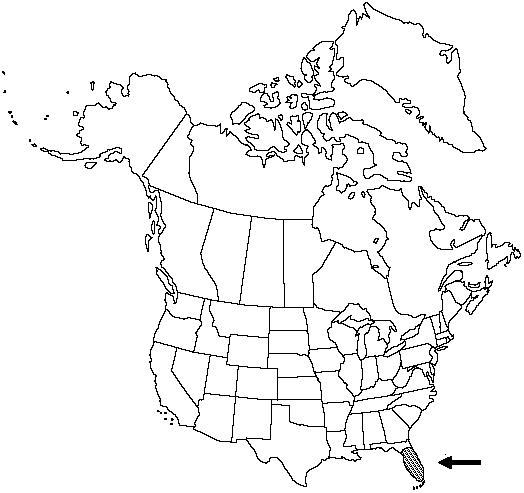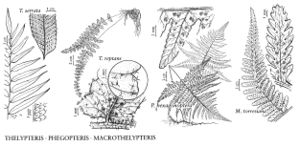Difference between revisions of "Thelypteris reptans"
Fieldiana, Bot. 28: 12. 1951.
FNA>Volume Importer |
imported>Volume Importer |
||
| (7 intermediate revisions by 2 users not shown) | |||
| Line 8: | Line 8: | ||
}} | }} | ||
|common_names=Creeping star-hair fern | |common_names=Creeping star-hair fern | ||
| − | |basionyms={{Treatment/ID/ | + | |special_status={{Treatment/ID/Special_status |
| + | |code=F | ||
| + | |label=Illustrated | ||
| + | }} | ||
| + | |basionyms={{Treatment/ID/Basionym | ||
|name=Polypodium reptans | |name=Polypodium reptans | ||
|authority=J. F. Gmelin | |authority=J. F. Gmelin | ||
| + | |rank=species | ||
| + | |publication_title=Syst. Nat. | ||
| + | |publication_place=2: 1309. 1791 | ||
}} | }} | ||
|synonyms={{Treatment/ID/Synonym | |synonyms={{Treatment/ID/Synonym | ||
|name=Dryopteris reptans | |name=Dryopteris reptans | ||
|authority=(J. F. Gmelin) C. Christensen | |authority=(J. F. Gmelin) C. Christensen | ||
| − | }}{{Treatment/ID/Synonym | + | |rank=species |
| + | }} {{Treatment/ID/Synonym | ||
|name=Goniopteris reptans | |name=Goniopteris reptans | ||
|authority=(J. F. Gmelin) C. Presl | |authority=(J. F. Gmelin) C. Presl | ||
| + | |rank=species | ||
}} | }} | ||
|hierarchy=Thelypteridaceae;Thelypteris;Thelypteris subg. Goniopteris;Thelypteris reptans | |hierarchy=Thelypteridaceae;Thelypteris;Thelypteris subg. Goniopteris;Thelypteris reptans | ||
| Line 26: | Line 35: | ||
}}<!-- | }}<!-- | ||
| − | --><span class="statement" id="st- | + | --><span class="statement" id="st-undefined" data-properties=""><b>Stems </b>creeping to suberect, 2–3 mm diam. <b>Leaves</b> somewhat dimorphic, evergreen, laxly arching or prostrate, sterile leaves often rooting at attenuate apices or along rachises, mostly (10–)15–55 cm, fertile leaves more erect and with longer petioles, not rooting, with more contracted pinnules. <b>Petiole</b> green, 1–25 cm × 0.5–1 mm, at base sparsely set with brown, lanceolate, stellate-hairy scales. <b>Blade</b> usually 10–30 cm, pinnate in proximal half only or throughout, narrowed distally to pinnatifid apex. <b>Pinnae</b> entire to crenate to shallowly lobed ca. 1/3 of width, 1–2.5(–5) × 0.3–1(–1.5) cm, sometimes subcordate at base; proximal pairs from adjacent segments usually united with excurrent vein or veins free. <b>Indument</b> abaxially of stellate, forked, and needlelike hairs on rachises, costae, veins, and blade tissue; blade tissue adaxially also with stellate hairs. <b>Sori</b> round, medial to supramedial; indusia minute or lacking; sporangia with stellate hairs. <b>2n</b> = 144.</span><!-- |
-->{{Treatment/Body | -->{{Treatment/Body | ||
| Line 40: | Line 49: | ||
-->{{#Taxon: | -->{{#Taxon: | ||
name=Thelypteris reptans | name=Thelypteris reptans | ||
| − | |||
|authority=(J. F. Gmelin) C. V. Morton | |authority=(J. F. Gmelin) C. V. Morton | ||
|rank=species | |rank=species | ||
| Line 53: | Line 61: | ||
|publication title=Fieldiana, Bot. | |publication title=Fieldiana, Bot. | ||
|publication year=1951 | |publication year=1951 | ||
| − | |special status= | + | |special status=Illustrated |
| − | |source xml=https:// | + | |source xml=https://bitbucket.org/aafc-mbb/fna-data-curation/src/2e0870ddd59836b60bcf96646a41e87ea5a5943a/coarse_grained_fna_xml/V2/V2_100.xml |
|genus=Thelypteris | |genus=Thelypteris | ||
|subgenus=Thelypteris subg. Goniopteris | |subgenus=Thelypteris subg. Goniopteris | ||
|species=Thelypteris reptans | |species=Thelypteris reptans | ||
| − | |||
| − | |||
| − | |||
| − | |||
| − | |||
| − | |||
| − | |||
| − | |||
| − | |||
| − | |||
| − | |||
| − | |||
| − | |||
| − | |||
| − | |||
| − | |||
| − | |||
| − | |||
| − | |||
| − | |||
| − | |||
| − | |||
| − | |||
| − | |||
| − | |||
| − | |||
| − | |||
| − | |||
| − | |||
| − | |||
| − | |||
| − | |||
| − | |||
| − | |||
| − | |||
| − | |||
| − | |||
| − | |||
| − | |||
| − | |||
| − | |||
| − | |||
}}<!-- | }}<!-- | ||
-->[[Category:Treatment]][[Category:Thelypteris subg. Goniopteris]] | -->[[Category:Treatment]][[Category:Thelypteris subg. Goniopteris]] | ||
Latest revision as of 20:21, 5 November 2020
Stems creeping to suberect, 2–3 mm diam. Leaves somewhat dimorphic, evergreen, laxly arching or prostrate, sterile leaves often rooting at attenuate apices or along rachises, mostly (10–)15–55 cm, fertile leaves more erect and with longer petioles, not rooting, with more contracted pinnules. Petiole green, 1–25 cm × 0.5–1 mm, at base sparsely set with brown, lanceolate, stellate-hairy scales. Blade usually 10–30 cm, pinnate in proximal half only or throughout, narrowed distally to pinnatifid apex. Pinnae entire to crenate to shallowly lobed ca. 1/3 of width, 1–2.5(–5) × 0.3–1(–1.5) cm, sometimes subcordate at base; proximal pairs from adjacent segments usually united with excurrent vein or veins free. Indument abaxially of stellate, forked, and needlelike hairs on rachises, costae, veins, and blade tissue; blade tissue adaxially also with stellate hairs. Sori round, medial to supramedial; indusia minute or lacking; sporangia with stellate hairs. 2n = 144.
Habitat: Limestone rocks and grottoes, damp woods
Elevation: 0–50 m
Distribution

Fla., s Mexico, West Indies, Central America in Guatemala, South America in n Venezuela.
Discussion
Selected References
None.
